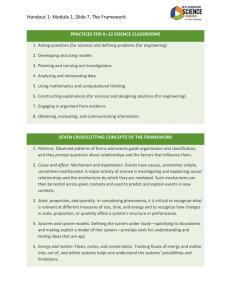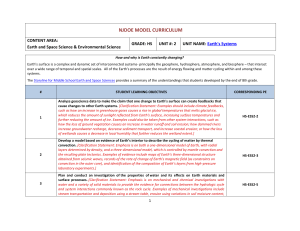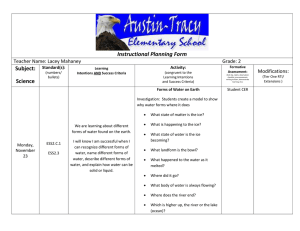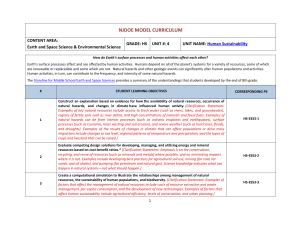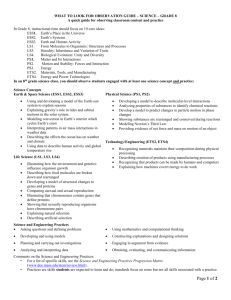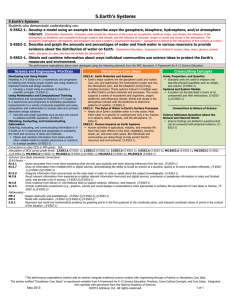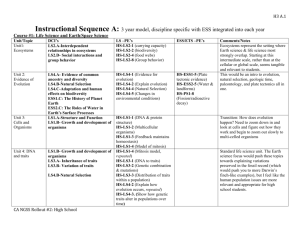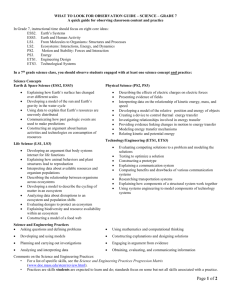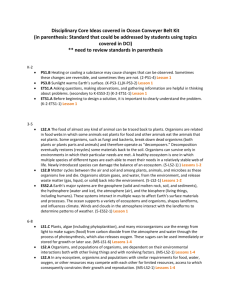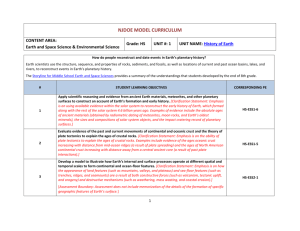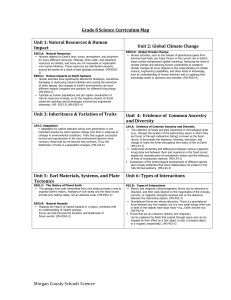Word - State of New Jersey
advertisement
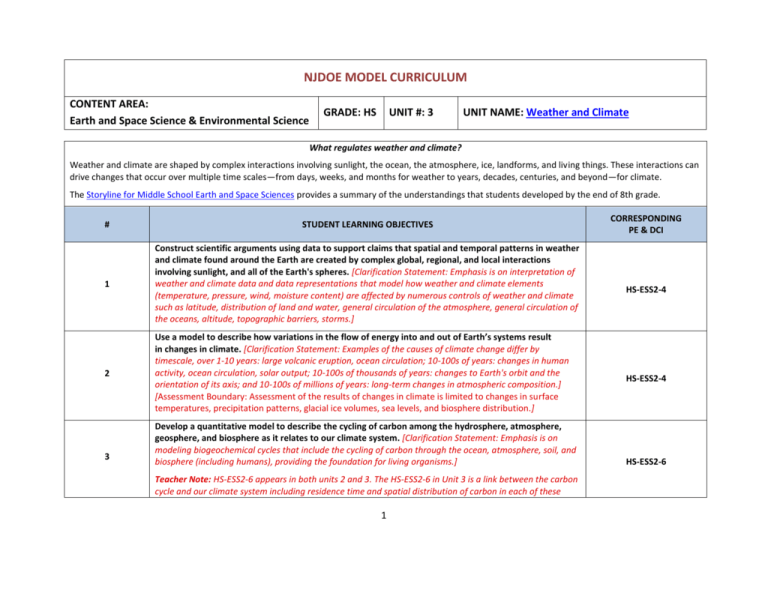
NJDOE MODEL CURRICULUM CONTENT AREA: Earth and Space Science & Environmental Science GRADE: HS UNIT #: 3 UNIT NAME: Weather and Climate What regulates weather and climate? Weather and climate are shaped by complex interactions involving sunlight, the ocean, the atmosphere, ice, landforms, and living things. These interactions can drive changes that occur over multiple time scales—from days, weeks, and months for weather to years, decades, centuries, and beyond—for climate. The Storyline for Middle School Earth and Space Sciences provides a summary of the understandings that students developed by the end of 8th grade. # STUDENT LEARNING OBJECTIVES 1 Construct scientific arguments using data to support claims that spatial and temporal patterns in weather and climate found around the Earth are created by complex global, regional, and local interactions involving sunlight, and all of the Earth's spheres. [Clarification Statement: Emphasis is on interpretation of weather and climate data and data representations that model how weather and climate elements (temperature, pressure, wind, moisture content) are affected by numerous controls of weather and climate such as latitude, distribution of land and water, general circulation of the atmosphere, general circulation of the oceans, altitude, topographic barriers, storms.] 2 Use a model to describe how variations in the flow of energy into and out of Earth’s systems result in changes in climate. [Clarification Statement: Examples of the causes of climate change differ by timescale, over 1-10 years: large volcanic eruption, ocean circulation; 10-100s of years: changes in human activity, ocean circulation, solar output; 10-100s of thousands of years: changes to Earth's orbit and the orientation of its axis; and 10-100s of millions of years: long-term changes in atmospheric composition.] [Assessment Boundary: Assessment of the results of changes in climate is limited to changes in surface temperatures, precipitation patterns, glacial ice volumes, sea levels, and biosphere distribution.] 3 Develop a quantitative model to describe the cycling of carbon among the hydrosphere, atmosphere, geosphere, and biosphere as it relates to our climate system. [Clarification Statement: Emphasis is on modeling biogeochemical cycles that include the cycling of carbon through the ocean, atmosphere, soil, and biosphere (including humans), providing the foundation for living organisms.] Teacher Note: HS-ESS2-6 appears in both units 2 and 3. The HS-ESS2-6 in Unit 3 is a link between the carbon cycle and our climate system including residence time and spatial distribution of carbon in each of these 1 CORRESPONDING PE & DCI HS-ESS2-4 HS-ESS2-4 HS-ESS2-6 NJDOE MODEL CURRICULUM CONTENT AREA: Earth and Space Science & Environmental Science GRADE: HS UNIT #: 3 UNIT NAME: Weather and Climate spheres. 4 Analyze geoscience data and the results from global climate models to make an evidence-based forecast of the current rate of global or regional climate change and associated future impacts to Earth systems. [Clarification Statement: Examples of evidence, for both data and climate model outputs, are for climate changes (such as precipitation and temperature) and their associated impacts (such as on sea level, glacial ice volumes, or atmosphere and ocean composition).] [Assessment Boundary: Assessment is limited to one example of a climate change and its associated impacts.] 2 HS-ESS3-5 NJDOE MODEL CURRICULUM CONTENT AREA: Earth and Space Science & Environmental Science GRADE: HS UNIT #: 3 UNIT NAME: Weather and Climate The performance expectations above were developed using the following elements from the NRC document A Framework for K-12 Science Education: Science and Engineering Practices Developing and Using Models (pp. 56-59) Students use, synthesizing, and developing models to predict and show relationships among variables between systems and their components in the natural and designed world(s). Use a model to provide mechanistic accounts of phenomena. (HS-ESS2-4) Develop a model based on evidence to illustrate the relationships between systems or between components of a system. (HS-ESS2-6) Analyzing and Interpreting Data (pp. 61-63) Students use more detailed statistical analysis, the comparison of data sets for consistency, and the use of models to generate and analyze data. Analyze data using computational models in order to make valid and reliable scientific claims. (HS-ESS3-5) Analyze data using tools, technologies, and/or models (e.g., computational, mathematical) in order to make valid and reliable scientific claims or determine an optimal design solution. (SLO-1) --------------- ---------------- -----Connections to Nature of Science Disciplinary Core Ideas ESS1.B: Earth and the Solar System (pp. 175-176) Cyclical changes in the shape of Earth’s orbit around the sun, together with changes in the tilt of the planet’s axis of rotation, both occurring over hundreds of thousands of years, have altered the intensity and distribution of sunlight falling on the earth. These phenomena cause a cycle of ice ages and other gradual climate changes. (secondary to HS-ESS2-4) ESS2.A: Earth Materials and Systems (pp. 179182) The geological record shows that changes to global and regional climate can be caused by interactions among changes in the sun’s energy output or Earth’s orbit, tectonic events, ocean circulation, volcanic activity, glaciers, vegetation, and human activities. These changes can occur on a variety of time scales from sudden (e.g., volcanic ash clouds) to intermediate (ice ages) to very long-term tectonic cycles. (HS-ESS2-4) ESS2.D: Weather and Climate (pp. 186-189) The foundation for Earth’s global climate systems is the electromagnetic radiation from 3 Crosscutting Concepts Patterns (pp. 85-87) Empirical evidence is needed to identify patterns. (SLO-1) Cause and Effect (pp.87-89) Empirical evidence is required to differentiate between cause and correlation and make claims about specific causes and effects. (HS-ESS2-4) Stability and Change (pp. 98-101) Change and rates of change can be quantified and modeled over very short or very long periods of time. Some system changes are irreversible. (HS-ESS3-5) NJDOE MODEL CURRICULUM CONTENT AREA: Earth and Space Science & Environmental Science Scientific Investigations Use a Variety of Methods Science investigations use diverse methods and do not always use the same set of procedures to obtain data. (HS-ESS3-5) New technologies advance scientific knowledge. (HS-ESS3-5) Scientific Knowledge is Based on Empirical Evidence Science knowledge is based on empirical evidence. (HS-ESS3-5) Science arguments are strengthened by multiple lines of evidence supporting a single explanation. (HS-ESS2-4),(HS-ESS3-5) GRADE: HS UNIT #: 3 UNIT NAME: Weather and Climate the sun, as well as its reflection, absorption, storage, and redistribution among the atmosphere, ocean, and land systems, and this energy’s re-radiation into space. (HS-ESS2-4) (SLO 1) Gradual atmospheric changes were due to plants and other organisms that captured carbon dioxide and released oxygen. (HS-ESS26) Changes in the atmosphere due to human activity have increased carbon dioxide concentrations and thus affect climate. (HSESS2-6),(HS-ESS2-4) ESS3.D: Global Climate Change (pp. 196-198) Though the magnitudes of human impacts are greater than they have ever been, so too are human abilities to model, predict, and manage current and future impacts. (HS-ESS3-5) 4 NJDOE MODEL CURRICULUM CONTENT AREA: Earth and Space Science & Environmental Science GRADE: HS UNIT #: 3 UNIT NAME: Weather and Climate Connections to other DCIs in this grade-band: HS.PS1.A (HS-ESS2-6); HS.PS1.B (HS-ESS2-6); HS.PS3.A (HS-ESS2-4); HS.PS3.B (HS-ESS2-4),(HS-ESS3-5); HS.PS3.D (HS-ESS3-5), (HS-ESS2-6); HS.LS1.C (HS-ESS3-5), (HS-ESS2-6); HS.LS2.B (HS-ESS2-6); HS.LS2.C (HS-ESS2-4); HS.ESS1.C (HS-ESS2-4); HS.ESS2.D(HS-ESS3-5); HS.ESS3.C (HS-ESS2-4), (HS-ESS2-6); HS.ESS3.D (HSESS2-4), (HS-ESS2-6) Articulation of DCIs across grade-bands: MS.PS1.A (HS-ESS2-6); MS.PS3.A (HS-ESS2-4); MS.PS3.B (HS-ESS2-4),(HS-ESS3-5); MS.PS3.D (HS-ESS2-4),(HS-ESS3-5), (HS-ESS2-6); MS.PS4.B (HS-ESS2-4), (HSESS2-6); MS.LS1.C (HS-ESS2-4); MS.LS2.B (HS-ESS2-4), (HS-ESS2-6); MS.LS2.C (HS-ESS2-4); MS.ESS2.A (HS-ESS2-4), (HS-ESS2-6), (MS-ESS3-5); MS.ESS2.B (HSESS2-4), (HS-ESS2-6); MS.ESS2.C (HS-ESS2-4), (HS-ESS2-6); MS.ESS2.D (HS-ESS2-4),(HS-ESS3-5);MS.ESS3.B (HS-ESS3-5); MS.ESS3.C (HS-ESS2-4), (HS-ESS2-6), (HSESS3-5); MS.ESS3.D (HS-ESS2-4), (HS-ESS2-6), (HS-ESS3-5) Common Core State Standards Connections: ELA/Literacy RST.1112.1 Cite specific textual evidence to support analysis of science and technical texts, attending to important distinctions the author makes and to any gaps or inconsistencies in the account. (HS-ESS3-5) RST.1112.2 Determine the central ideas or conclusions of a text; summarize complex concepts, processes, or information presented in a text by paraphrasing them in simpler but still accurate terms. (HS-ESS3-5) RST.1112.7 Integrate and evaluate multiple sources of information presented in diverse formats and media (e.g., quantitative data, video, multimedia) in order to address a question or solve a problem. (HS-ESS3-5) SL.11-12.5 Make strategic use of digital media (e.g., textual, graphical, audio, visual, and interactive elements) in presentations to enhance understanding of findings, reasoning, and evidence and to add interest. (HS-ESS2-4) 5 NJDOE MODEL CURRICULUM CONTENT AREA: Earth and Space Science & Environmental Science GRADE: HS UNIT #: 3 UNIT NAME: Weather and Climate Mathematics MP.2 Reason abstractly and quantitatively. (HS-ESS2-4), (HS-ESS2-6), (HS-ESS3-5) MP.4 Model with mathematics. (HS-ESS2-4), (HS-ESS2-6) HSN.Q.A.1 Use units as a way to understand problems and to guide the solution of multi-step problems; choose and interpret units consistently in formulas; choose and interpret the scale and the origin in graphs and data displays. (HS-ESS2-4), (HS-ESS2-6), (HS-ESS3-5) HSN.Q.A.2 Define appropriate quantities for the purpose of descriptive modeling. (HS-ESS2-4), (HS-ESS2-6), (HS-ESS3-5) HSN.Q.A.3 Choose a level of accuracy appropriate to limitations on measurement when reporting quantities. (HS-ESS2-4), (HS-ESS2-6), (HS-ESS3-5) 6
